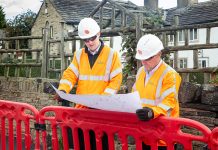On March 22 the Eastern Area celebrated ‘World Environment Day’ with a seminar to analyse the asset management plan period (AMP5) for 2010 to 2015 – ‘What the Future Holds’.
The Eastern Area were delighted to welcome 4 speakers from the water industry. Their presentations gave an insight in to the price review and agreement process with the Water Services Regulation Authority (OFWAT) and they embraced the Presidents Theme 2010 – ‘The Customer Experience’. The first speaker was Stephen Morley (Regulation Manager) from Cambridge Water, who gave a presentation on the Price Review Process. This documents how the water company proposes to finance the needs of its customers and stakeholders. All water companies have 4 key regulators which are: the Environment Agency, Drinking Water Inspectorate, Consumer Council for Water and OFWAT. The Environment Agency regulates water industry water use (e.g. future growth) and wasterwater quality. The Drinking Water Inspectorate monitors the quality of water produced (e.g. nitrates in raw water) and the Consumer Council for Water is the water industry watchdog. OFWAT sets the annual price limits for each water company, which allow efficient companies to finance their functions. It also provides companies with incentives to keep within their operating costs and maintain their assets to the minimum cost necessary. Cambridge Water prepared its PR09 plan by producing a Strategic Direction Statement (SDS), which included a water demand statement, quality requirements (e.g. nitrate removal from raw water), achievable efficiencies and customer engagement.
The next speaker was Ken Oswald (Head of Economic Regulation) at Northumbrian Water Limited (NWL). He gave a presentation on Satisfying Customers – the changing focus, which reviewed the changes water companies have experienced since privatisation in 1989 when they went from consumer to customer supply and treatment. The regulatory service has improved significantly and NWL customers are consistently scoring the company high for customer satisfaction, with overall mean scores of 8/10. However, there are still improvements to be made and Ken showed the audience a series of photographs illustrating some NWL and contractor mistakes. These included blocking a customer drive with barriers to cover a hole (without notification) and positioning a water meter internally behind a television cabinet! This could have been positioned outside if the employee or contractor had investigated the external pipework more thoroughly. NWL’s approach is to improve customer satisfaction by minimising service failure and its impacts through best practice implementation. So far NWL have held ‘right first time, everytime’ workshops across billing, metering and distribution functions, together with a ‘right first time’ mailbox for customers. The NWL strategic direction statement includes company performance targets, where all customers are satisfied with the service NWL provides and customers should have no cause for complaint. The 2020 goals regarding this include an average customer satisfaction score of 8.5; resolve 80% and 95% of contacts for operational issues and billing respectively at the first point of contact.
The third speaker was Guy Chalkley (Director of Finance) at Veolia Water Central (VWC), who presented on the Customer Experience and the Final Determination. During Veolia’s PR09 process OFWAT highlighted infrastructure serviceability as a key requirement of AMP5. This was due to the company’s historic performance, especially water delivery and pipe bursts (greater notification and leakage detection required). In maintaining serviceability, VWC performed very well, with compliance in respect to iron levels in water and distribution losses. In terms of OPEX efficiency, VWC has been placed in Band C Lower after the PR09 draft determination and therefore needs to achieve large efficiencies. To do this the company needs to acquire other contracts, share knowledge and change behaviour. So far the number of interruptions to supply (DG3) has reduced from 2,520 in 2008/9 to 1,663 in 2009/10, which is great progress. For the customer experience process, VWC hopes to understand customer requirements by providing an appropriate solution that satisfies the customer and strengthens their relationship.
The final speaker was Andrew Snelson (Economic Regulation Manager) from Anglian Water. His presentation concerned the principle investment areas for AMP5 within Anglian Water. The first area is water quality, which includes the replacement of 11,000 lead pipes in high risk zones, with phosphate dosing in medium risk areas. An environmental programme, which includes first time sewerage connections for 2,970 properties, flow compliance schemes at 55 wastewater treatment works and 80% enhanced sludge treatment. Growth investments, particularly the maintenance of the security supply index (SoSi), continued reduction in leakage and 124,000 new meter optants. The fourth investment area is growth provision, which includes the additional treatment capacity development at Anglian Water’s wastewater treatment works. The final investment area concerns service enhancement, where there will be relief from sewer flooding risk for 312 existing high risk properties and 52 low risk properties. There will also solutions for 346 external flooding problem sites and odour nuisance reduction at 91 sites. The key regulatory themes for AMP5 in Anglian Water are greater flexibility for companies to provide best value, develop a longer term focus (especially with regard to climate change) and sustainable water. A range of interesting questions were asked at the end of the seminar and included questions on the polluter pays principle: why does the customer have to pay for additional water treatment when it has not caused the pollution? This particularly concerns nitrate pollution, it is very difficult to determine where it has come from and who has caused it. The presenters agreed that as a result the water companies have to treat the water and include additional treatment processes.
Differences in OFWAT’s determination for each water company were discussed in relation to water meters. For instance water metering has been included in Anglian Waters determination but not in the Cambridge Water Company final draft plan. Stephen Morley replied that in the Cambridge area, there is a water supply surplus and OFWAT did not therefore believe that metering was necessary. Andrew Snelson also told the audience that Anglian Water is in one of the driest parts of the country and metering is therefore deemed necessary by OFWAT to control and monitor supply.





